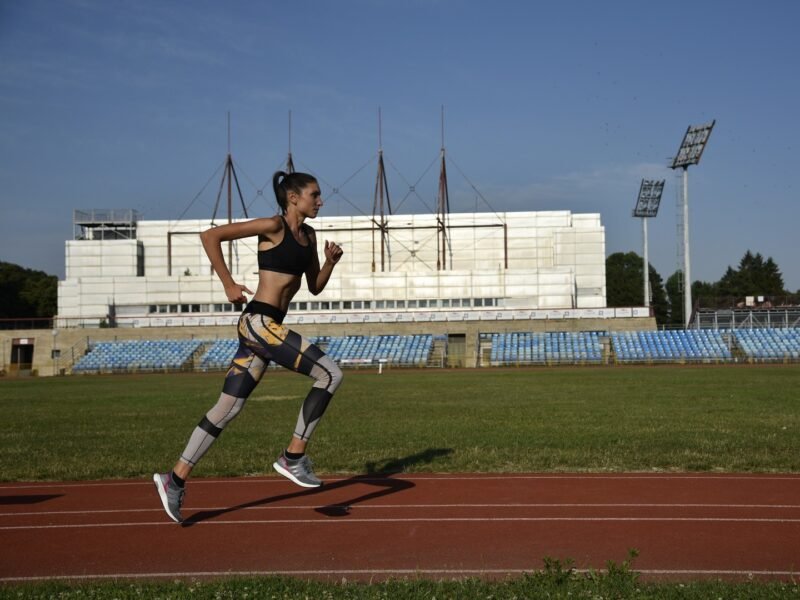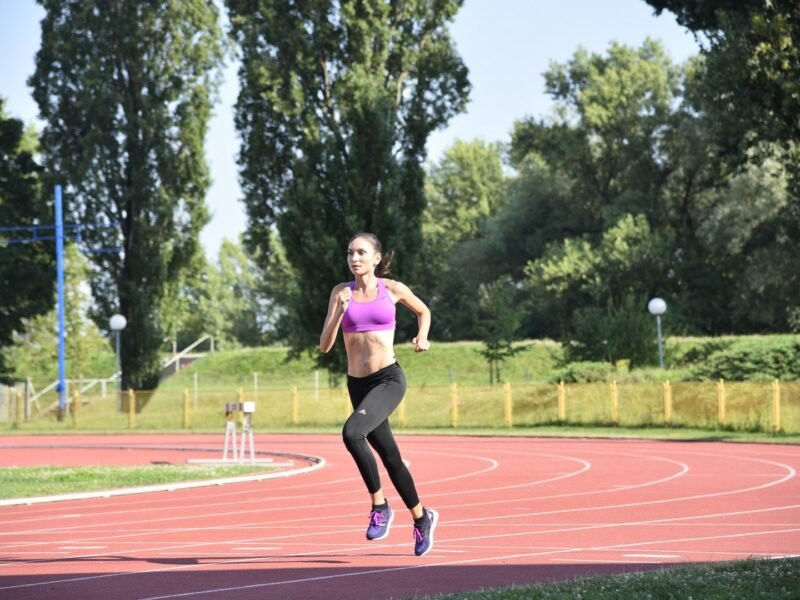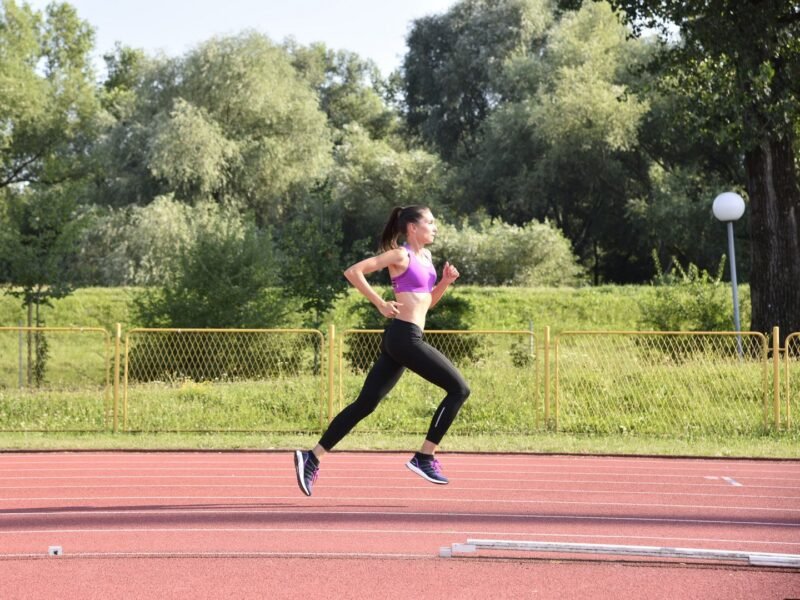What Are Running Strides And How To Do Them?
If you ever followed some training plan, you have certainly heard about running strides.
But what are running strides and how to do them properly? How to include them in your training plan?
In this article, I will answer you 10 most frequently asked questions about running strides.
What are running strides?
Running strides are gradual accelerations at distances between 60 and 100 meters. They are done from a completely slow pace to 90 percent of maximum speed. Running strides are used for improving running technique and developing speed.

How to do running strides?
1. Start slowly and gradually accelerate
Running strides are done by slowly increasing the pace to the speed where you can run with proper technique – a fast, but also controlled pace (for most runners that is around 90% of their maximum running speed).
It is important to run fast, but it is even more important to maintain complete control over your movements so that you do not disrupt your running technique.
Running pace is not important. Do not compete with yourself or anyone else.
Running strides are not separate training, but an exercise that helps develop speed and prepare you for fast running with proper technique.
Tip
When doing running strides, listen to your body and run according to your feeling. Do not bother with pace, but concentrate on proper running technique.
2. Run from 60m to 100m
Running strides are done from 60 to 100 meters. It is unnecessary to do them for more than 100 meters because that changes the whole purpose of the exercise.
By running for more than 100 meters, you transition into interval training and lose all the benefits of running strides.
Tip
By running for more than 100 meters, you transition into interval training, the section lasts longer, and it becomes harder to run fast and focus on proper running technique.
3. Rest completely between repetitions
After each running stride, walk back to the starting position or rest in place.
It is important to rest between running strides. Do not rush and shorten your recovery time to do more of them.
It is better to do fewer repetitions and rest longer between each running stride than to disrupt proper running technique.
4. Pay attention to the proper running technique
By doing running strides, you learn how to run fast with proper running techniques.
Because of that, you should:
- Keep your body straight slightly lean forward
- Focus on proper arms coordination
- Run relaxed, without strain
- Run on the balls of your feet
- Gradually increase cadence (number of steps in a minute)

When should you do running strides?
Running strides should be done as a part of a warm-up routine before more intensive training, such as intervals and tempo runs, or before a race. Likewise, it is good to do them immediately after an easy training, in preparation for the next day’s more intensive training.
Before you start doing running strides, warm up with 10-15 minutes of easy jogging, and then do mobility exercises and dynamic stretches. Only after a good warm-up, you should do them.
Do the running strides after you have raised your body temperature and heart rate. It is important that you warm up but still be rested and fresh enough to focus on proper running technique.
Read more: Warm-up Before Running [Ultimate Guide]
Example of warm-up routine before interval training (15 x 400m):
1. Easy jogging (10 minutes)
2. Mobility exercises and dynamic stretches (5 minutes)
3. Running drills – 2 x 40m ankling, 2 x 40 high knees, 2 x 40m butt kicks
4. Running strides – 3 x 60m
How often should you do running strides?
For beginners, it is sufficient to include running strides once a week into their training plan. As the body adapts, you can gradually increase the number of days when you do running strides.
For advanced runners, it is recommended to do running strides 3 to 5 times a week as a part of their training.
Running strides have several benefits which is why it is good to include them in your training plan. However, it is important to gradually increase the number of repetitions to avoid any injuries.
Below, I will show you an example of how beginners can include running strides into their training plan.
| Week | Distance | Number of repetitions | Number of days in a week |
|---|---|---|---|
| 1 | 60m | 2 | 1 |
| 2 | 60m | 2 | 2 |
| 3 | 60m | 3 | 2 |
| 4 | 60m | 4 | 2 |
| 5 | 100m | 3 | 1 |
| 6 | 100m | 3 | 2 |
Tip
Adjust the distance and number of running strides to the training and your abilities.

Where can you do running strides?
One of the benefits of running strides is that they can be done anywhere. It is preferable to do them on flat, smooth terrain so that you can focus on proper running technique, without thinking about possible bumps.
The most ideal place to do them is on an athletic track, but most of you do not have access to one. However, running strides can be done on a road, on an embankment, in a forest, or on a grassy field. On a grassy surface, you can do running strides barefoot to further strengthen and develop foot strength.
If you are preparing for a race on an athletic track and you decide to run in spikes, then you should do running strides in them. That way your foot can adjust to the transition from sneakers to spikes.
Who can do running strides?
Running strides can be done by beginners and advanced runners, regardless of whether you run long or short distances.
Long-distance runners do running strides to improve their maximum speed, maintain proper running technique, and break the monotony of their training.
Runners who get back to running after an injury or pregnancy should do running strides in order to run at a faster pace, without straining their bodies as much as they would during interval training or tempo runs.
Runners who often get injured should do running strides to improve their running technique and reduce the risk of injury.
Short-distance runners do running strides to improve their maximum speed and strength and to maintain proper running technique.
Why should you do running strides?
1. Running strides prepare the body, mentally and physically, for more intensive training or a race – they help you get used to the feeling of faster running.
2. Running strides activate your fast-twitch muscle fibers after long and easy training – it is sufficient to do a couple of running strides to refresh your tired legs after long training.
3. Running strides help break the monotony – they allow you to include faster running into your training plan without having to sacrifice your entire training.
4. Running strides improve your running technique – they only last for about 15 seconds during which you can completely focus on proper running technique, which allows you to improve your running economy.
5. Running strides improve your neuromuscular coordination – by improving communication between your nerves and muscle fibers, you will be better coordinated, and your muscles will be better prepared for more intensive training or a race.
6. Running strides are short and can be done anywhere – they last for only a couple of seconds and you can do them anywhere, under the condition that you have enough space.
Do running strides improve speed?
Running strides help in developing speed and are a great speed exercise for beginners and, as well for advanced runners. They last only about 15 seconds during which you can easily focus on proper running technique. Running with proper technique will reduce the risk of injury and increase running speed.
You have probably often tried to accelerate while running. However, all of a sudden, your legs were not listening. One of the reasons why that happened is your body not being accustomed to the feeling of faster running and you were not able to control such fast movements. By including running strides into your training, you gradually introduce your body to faster running and it adapts to the feeling of it.
Are running strides the same as sprinting?
Many people think that running strides are the same as sprinting but, despite appearing similar, they are quite different.
Contrary to sprinting, the goal of running strides is not to run at maximum speed but to focus on proper running technique and gradually accelerate to get the body used to the feeling of running faster.
There is also a difference in the way that running strides are done. They are based on feeling, and having control of your movements, while the goal of sprinting is to achieve maximum speed as fast as possible. When doing running strides, it’s not the pace that matters, it’s your own feeling.
Can you do running strides on a treadmill?
Running strides can be done on more advanced treadmills which automatically follow your pace, that is, on the ones that do not require you to change the pace manually.
It is not recommended to do running strides on classic treadmills because you cannot focus on proper running technique and change the pace manually at the same time.
Although it is possible to do running strides on the treadmill, I always suggest that you do them outside in nature.

Matea Matošević
Hi, I’m Matea! I’m an Olympic Marathon Runner, founder, and writer behind OLYRUN.com. On this site, I provide help in the form of my knowledge and experience to all who love running and active living. Read more…

